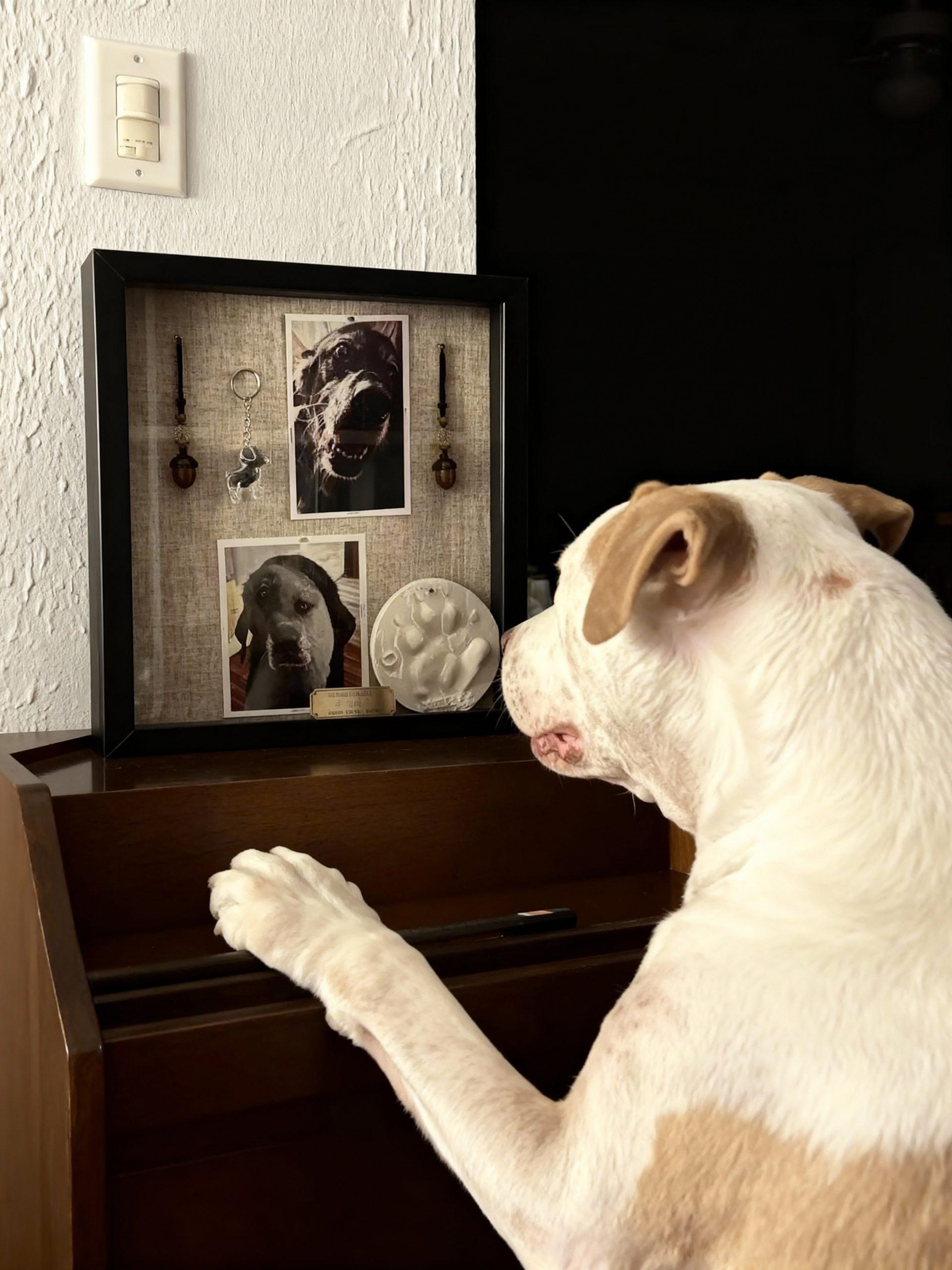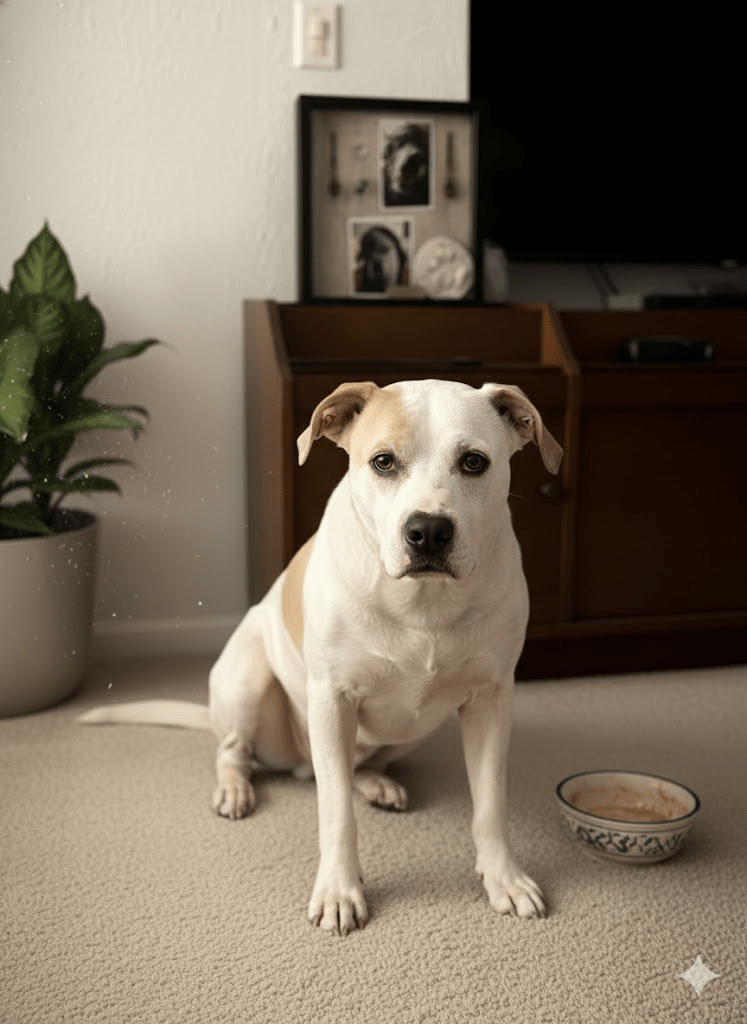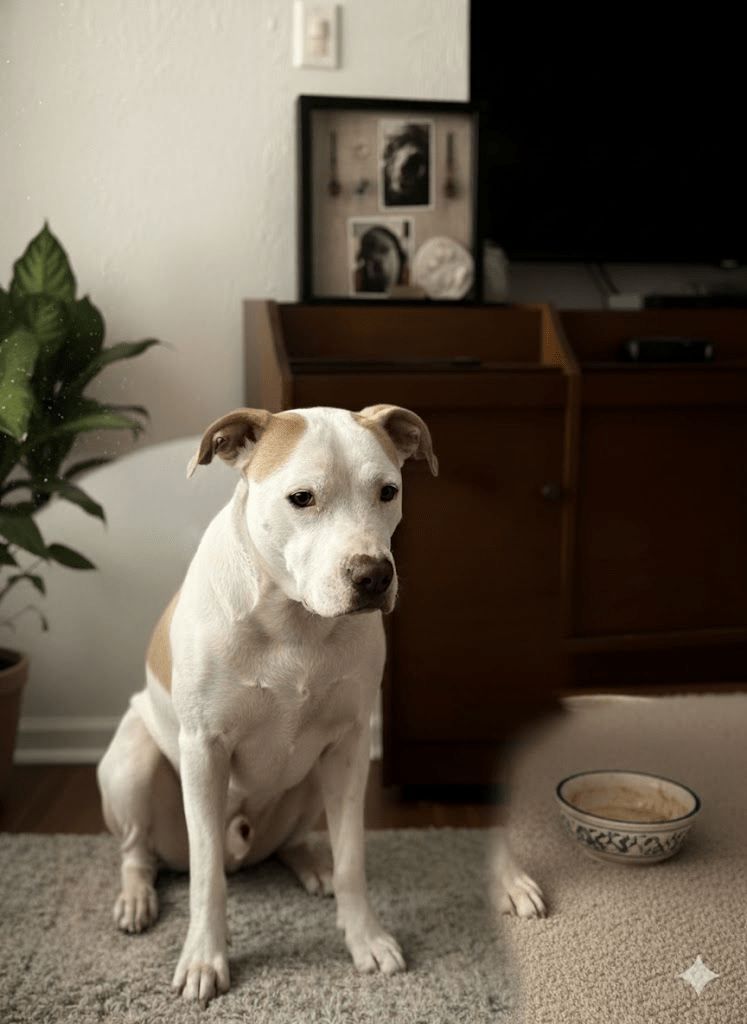The quiet moments of grief are not exclusively human. As sentient beings with deep emotional capacities, dogs often form intense bonds with their human and animal companions. The profound absence left by a loved one can be felt keenly by them, manifesting in various behaviors that mirror human mourning. The image before us captures a deeply touching and solitary moment: a white and tan dog, with head slightly lowered and an air of quiet contemplation, gazes at a framed memorial. Inside the frame, two photographs of a darker-furred dog, perhaps a cherished friend or family member, are displayed alongside what appears to be a paw print casting and small, personal mementos. This scene is a poignant testament to the emotional depth of dogs, offering a rare glimpse into the often-unseen world of their grief. It prompts us to consider how our canine companions navigate loss, how they remember, and how we, as their guardians, can better understand and support them through such challenging times. This article delves into the various facets of canine grief, exploring the signs, the science, and the compassionate ways we can help our beloved pets cope with the sorrow of absence.

Recognizing the Signs of Canine Grief
Just as with humans, grief in dogs can manifest in diverse ways, often influenced by their individual personalities, the nature of their bond with the departed, and their past experiences. Common behavioral changes in grieving dogs include a noticeable decrease in appetite, leading to weight loss, and a general lack of enthusiasm for activities they once enjoyed, such as walks, playtime, or even treats. They might become more subdued, withdrawn, and less interactive with other household members. Some dogs may exhibit restless behaviors, such as pacing, whining, or increased vocalization, as if searching for their lost companion. Others might seek out places where the departed pet or person used to sleep or spend time, lying there as if awaiting their return. Changes in sleep patterns, either sleeping significantly more or struggling with insomnia, are also frequently observed. It’s not uncommon for grieving dogs to display signs of anxiety, such as excessive licking, destructive behaviors, or house-soiling, even if they were previously well-trained. A key indicator is a sustained change in their usual demeanor and habits that persists beyond a few days, signaling a deeper emotional struggle.

The Science Behind Their Sorrow
While we cannot interview dogs about their feelings, scientific research and extensive anecdotal evidence strongly suggest that dogs experience emotions akin to grief. Studies have shown that dogs exhibit physiological responses to stress and sadness, including changes in hormone levels (like cortisol, the stress hormone) and brain activity, when separated from or losing a close companion. Dogs are highly social animals, forming complex attachments within their social groups, whether those are human or canine. When a member of their “pack” disappears, it disrupts their established routines, social structures, and emotional security. They miss the companionship, the play, the shared meals, and the comforting presence of the individual. Their understanding of “death” might not be the same as ours, but they certainly grasp the concept of absence and the permanent loss of a loved one from their daily lives. The bond between animals can be incredibly strong, often built over years of shared experiences, mutual comfort, and unspoken communication. This profound connection makes the sorrow of separation a very real and impactful experience for them.

How to Support Your Grieving Dog
Navigating a pet’s grief while simultaneously coping with your own loss can be incredibly challenging, but providing support to your dog is crucial for their emotional well-being. Establishing and maintaining a consistent routine is paramount; predictable schedules for feeding, walks, and playtime can offer a sense of security in an otherwise disorienting time. While it’s natural to want to comfort your dog, avoid inadvertently rewarding their sadness with excessive fussing, which could reinforce mournful behaviors. Instead, offer gentle affection and engage them in positive, low-key activities. Short, frequent walks can provide distraction and mental stimulation, and a quiet game of fetch or a puzzle toy can encourage engagement without overwhelming them. Some dogs find comfort in the familiar scents of their departed companion; a blanket or an unwashed toy can provide a subtle, reassuring connection, though this should be monitored to ensure it doesn’t prolong their distress.

Considering a New Companion
The decision of when, or if, to introduce a new pet into the household after a loss is deeply personal and should be approached with careful consideration. There is no universal timeline for grieving, for either humans or animals. Some dogs may benefit from the companionship of a new friend relatively quickly, while others may need a much longer period to adjust to their loss. Introducing a new pet too soon can sometimes lead to resentment or an inability for the grieving dog to form a bond, especially if they are still deeply distressed. When you do decide to open your home to a new companion, consider the personality and energy levels of both animals. A gentle, calm new addition might be more suitable for a sensitive, grieving dog, while a boisterous puppy could be overwhelming. Gradual introductions in neutral territory, supervised interactions, and providing separate resources (bowls, beds, toys) can help facilitate a smoother transition. The goal is to ensure that the new pet is seen as a welcome addition that brings joy, rather than a replacement that creates further stress.







